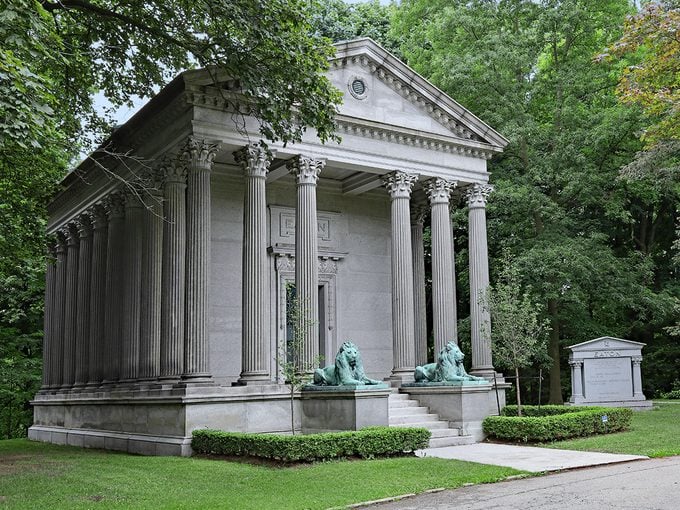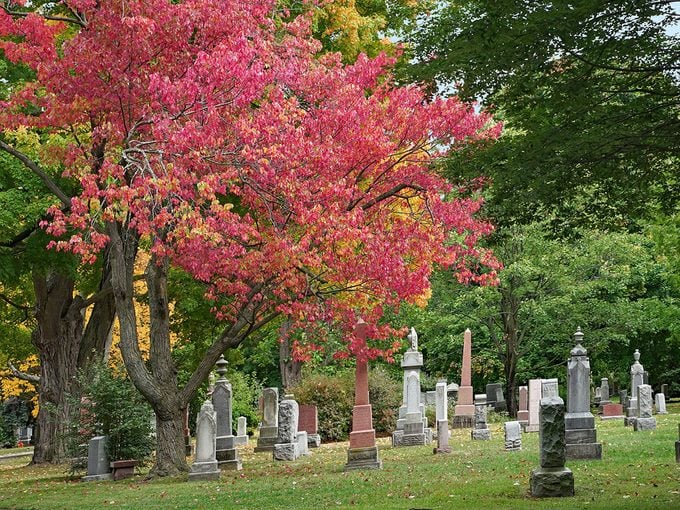More Than Just a Cemetery: Exploring Toronto’s Mount Pleasant Cemetery
Toronto’s historic Mount Pleasant Cemetery is the final resting place of many prominent Canadians, and boasts one of North America’s most impressive tree collections.

Why Mount Pleasant Cemetery is one of Toronto’s most overlooked gems
Just beyond my backyard fence lies Mount Pleasant Cemetery. From my balcony, I look over gravestones, some of which date back to the mid-1800s. Ever since I was a child, I’ve been fascinated by cemeteries, especially very old tombstones. The dates on them, combined with my active imagination, take me back in time to a different way of life. So when I moved into my home in Toronto, I looked forward to exploring this cemetery and knew I’d learn more of the city’s history from its gravestones and mausoleums. What I didn’t know was that my visits would also teach me about trees.
My first walks through the cemetery were focused on the gravestones, both for their design and the glimpse into Toronto’s past. Among the notable names I recognized were William Lyon Mackenzie King, former prime minister of Canada; Timothy Eaton (above), founder of Eaton’s department stores, and Sir Frederick Banting and Charles Best, co-discoverers of insulin.

After several visits, I began to look at the trees as well and noticed there were many I wasn’t familiar with. I began looking more closely at the bark, leaves and flowers, and found myself stopping to read the small green signs that identified the species. At home I would look them up on the Internet and learned that leaves can be broad, flattened and scale-like; bark wasn’t just bark, it can be fissured, furrowed, scaly or smooth and some trees, such as the London plane, shed their bark. I was hooked.
In 1873, the Toronto General Burying Grounds trust purchased 200 acres for a new city cemetery and assigned the layout to landscape architect Henry Englehardt, who envisioned a park-like setting. The cemetery was so different from other burial grounds and so beautiful that an early city souvenir guidebook told tourists that, “No visit to Toronto will be complete without a visit to Mount Pleasant Cemetery.” If I were writing a guidebook now, I’d say the same thing. In fact, in the modern day version of a guidebook—the website TripAdvisor—tourists have given Mount Pleasant a five-star rating.
Not only did Henry Englehardt want the cemetery to be a park, he wanted it to be an arboretum. He would be pleased to know that Mount Pleasant is now considered to have one of the finest tree collections in North America. There are hundreds of trees, both native and introduced, of every shape and size.

In spring and summer, when I look at the foliage, I try to remember every one of the words used to describe what we call “green,” as green is not enough. And in the fall, words fail altogether. Among the pioneer trees, on average 130 years old, stand oaks that were on the property when it was still a farmer’s field. They and the heritage trees have witnessed the cemetery’s beginnings and its growth. The trees in Mount Pleasant, like the markers, have their own stories to tell.
Just over my fence is a cemetery that is so much more than that. It is the beautiful resting place for thousands of Toronto’s citizens, a National Historic Site, a park, a nature preserve and arboretum. And it is the place where I learned about trees.
Check out more of Canada’s most beautiful cemeteries.






